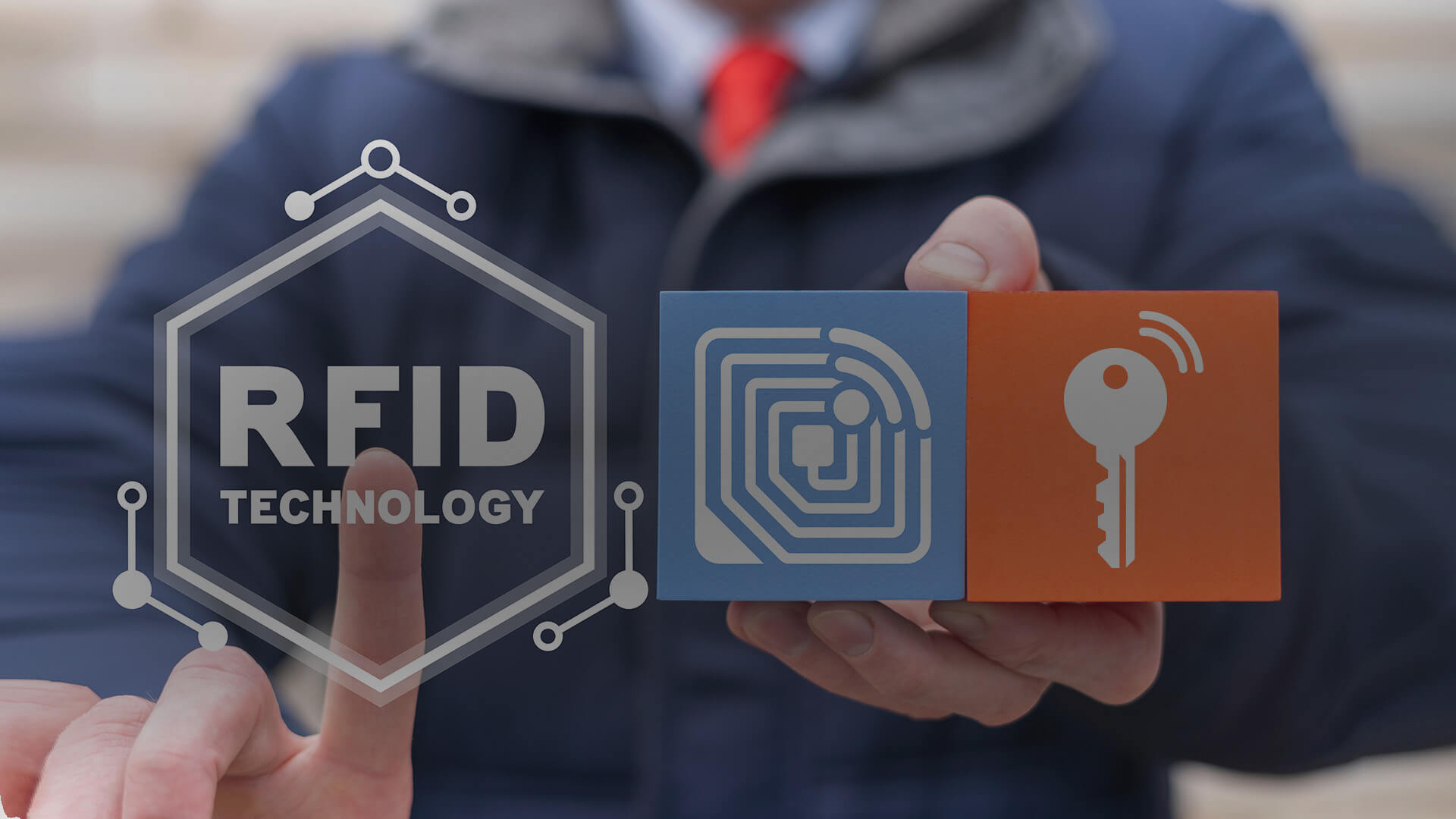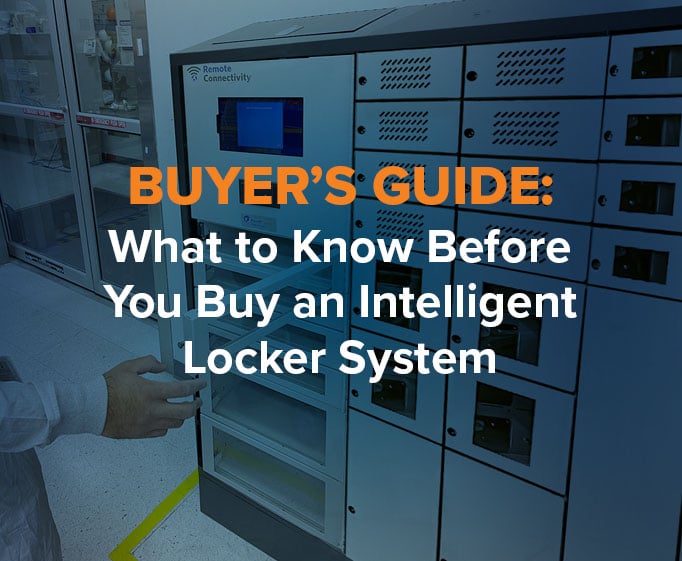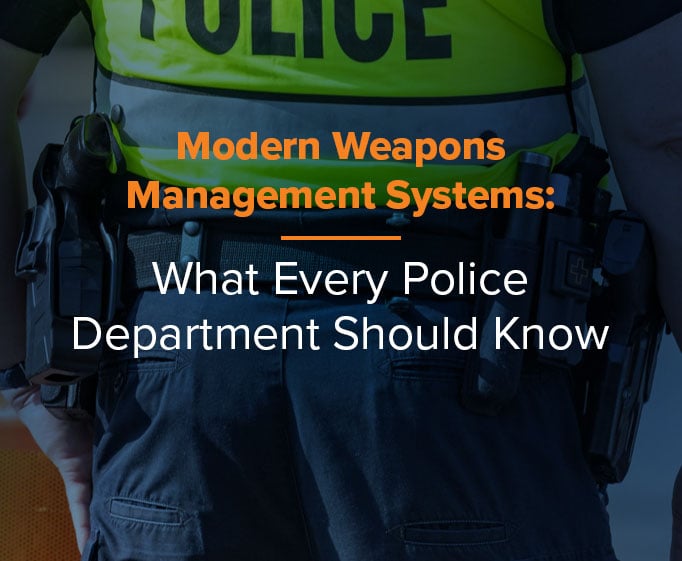By Jay Palter | October 7, 2025
Managing physical keys can feel like a never-ending headache. Even as workplaces become more digital and remote, physical keys remain essential, especially for vehicles, storage lockers, and other assets where electronic access control isn’t always an option. Keys endure because they are reliable, cost-effective, and widely adopted.
However, if you’re responsible for tracking keys across your organization, you need a more intelligent solution. That’s where RFID-based key management systems come in. They deliver the best return on investment (ROI) by combining long-term durability, reliable performance, and intelligent software that eliminates common pain points.
In this article, we’ll also clear up common misconceptions and myths about RFID key fobs, compare them to metal plug alternatives, and explain why RFID delivers superior long-term value for organizations in law enforcement, corrections, enterprise, and beyond.
What is a Key Management System?
A key management system is the combination of hardware and software that organizations use to secure, organize, and track physical keys. Instead of relying on manual logs or unsecured storage, a key management system automates these tasks to provide accountability, reduce losses, and streamline operations.
[Quiz] - Is Your Physical Key Management System Secure and Efficient?
Take the Quiz >
Key Components of a Key Management System
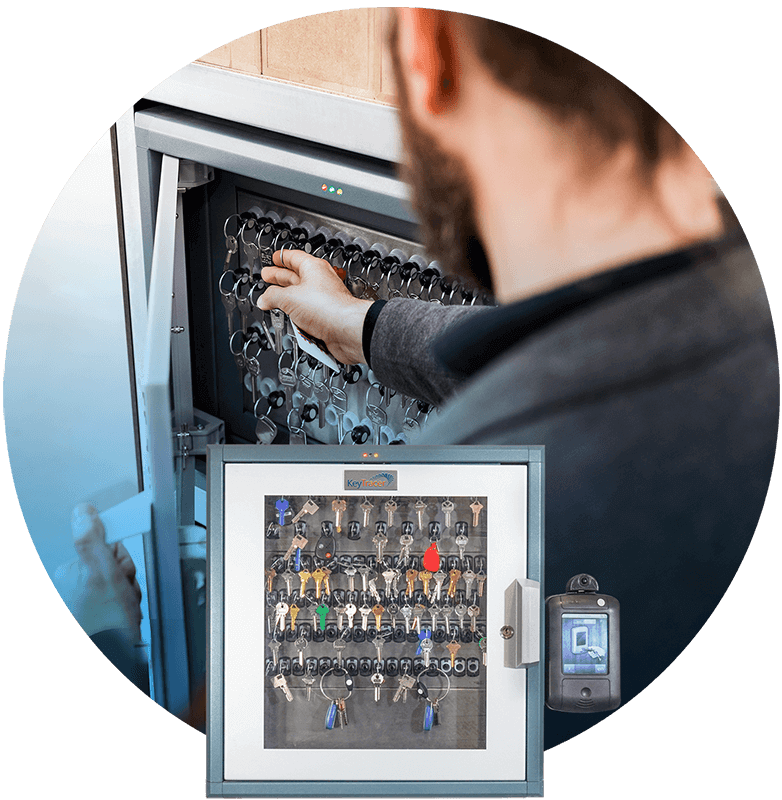
Key Storage Cabinets
At the core of every system is a secure cabinet. Cabinets use individual locking slots to protect each key ring. Different panel sizes and slot layouts allow organizations to scale capacity to the number of keys they need to manage at a location.
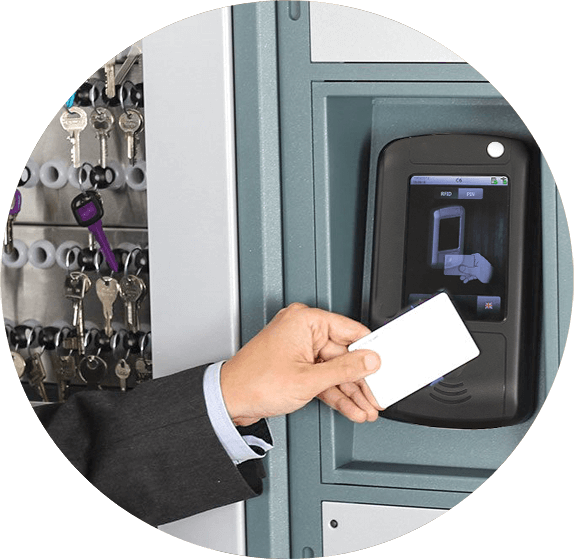
Access Terminals
Users authenticate themselves at an access terminal before taking or returning keys. Entry-level systems may use PINs entered into a keypad, while advanced models include digital touchscreens paired with secure access controls such as proximity cards or biometrics, including multi-factor authentication and even dual or triple authorizations.
Touchscreens can also prompt users for information at sign-out or return. For example, fleet managers can require drivers to log mileage and vehicle condition before returning a key.

Key Tags / Fobs
Every keyring is attached to a key tag, also known as a fob, that uniquely identifies it to the system.
When a user authenticates and requests a key, the system releases only the correct keyring. Upon return, the system reads the key tag to verify that the proper keyring is being returned.
This ensures a complete digital audit trail of who accessed which keys, when, and under what conditions.

Management Software
All transactions and user activity are centralized in a single software system.
Administrators can configure permissions by role, department, or job type, generate detailed chain-of-custody reports, and monitor patterns in key use or loss.
Secure dashboards are available on authorized computers and mobile devices, giving organizations real-time oversight.
Cloud or On-Premises: The centralized software may be deployed on-premises or as a SaaS solution, depending on the customer’s requirements and preferences.
ROI & Durability in Key Management
While features matter, the objective measure of a key management system’s value is its lifecycle ROI.
That means:
- Fewer replacement parts
- Less downtime
- Reduced maintenance
- Stronger accountability
RFID: A Modern Technology Solution
Don’t be misled by claims that RFID is outdated. RFID is not a legacy workaround—it is a proven, modern technology at the core of many of the world’s most advanced security and logistics systems.
- In the automotive industry, manufacturers such as Volkswagen, Audi, and Porsche utilize RFID in projects like the Transparent Prototype to track prototype parts and manage complex supply chains, ensuring that every component is accounted for throughout the production process.
- Retail leaders like Walmart and Zara use RFID for near real-time inventory visibility, maintaining stock accuracy above 95%.
- Governments deploy RFID-enabled passports and ID cards to deliver secure, high-throughput border control.
RFID and Key Management Systems
In the context of key management, RFID delivers the same benefits of speed, accuracy, and accountability. It enables:
• Role-based access controls that align with organizational policies
• SSO and Active Directory integration for seamless user management
• Real-time alerts and curfew enforcement to stop problems before they escalate
• Complete digital audit trails for compliance and investigations
Combined with the unmatched durability of RFID fobs, these capabilities give organizations a solution that is not only secure and efficient today but also scalable for tomorrow’s operational challenges.
Pro tip: Ask your vendor about their fob warranty. It’s often a good indicator of real-world quality.
RFID Key Management Systems Improve Business Operations
An electronic key management system has two primary jobs:
- Securely storing and distributing keys.
- Providing actionable data on key use.
Both are done far more effectively than any manual process. At the most basic level, a key management system does what pen-and-paper never can:
- Automate security
- Eliminate errors
- Give managers real-time insight.
The RFID benefits go well beyond convenience
Lower ongoing management costs
Staff previously tied up managing keys can be redirected to higher-value work. Automated cabinets operate 24/7 without fatigue or human error, ensuring consistent key control at all times.
Prevent losses
With curfew alerts, supervisors know immediately when keys aren’t returned on time, giving them the best chance to recover them quickly.
For even stronger protection, organizations can integrate a Key Exit Alarm System. It automatically detects when keys are taken outside authorized areas, triggering instant alerts so security teams can intervene before a loss occurs.
Improve access control
Only authorized staff can access specific keys, eliminating mistakes and enforcing policy every time.
Optimize your operations
Protect the assets keys unlock — vehicles, facilities, equipment — by tightening control. Staff can even reserve keys in advance, ensuring assets are ready when needed.
Fact Check:
RFID Fobs

RFID fobs are inserted into a slot and are read electronically by an RFID chip. They do not depend on constant physical contact to function.
This design eliminates many of the wear and corrosion issues found in metal-to-metal plug systems. At Real Time Networks, RFID fobs are engineered for long-term use and backed by a lifetime warranty.
Their durability has been proven under extreme conditions, as demonstrated in our KeyTracer Key Fob Stress Test. This level of resilience minimizes replacement costs and ensures reliability even in demanding environments.
Known Issues with Metal-to-Metal Plugs
Some vendors promote steel ID plugs as superior because they are metal. The reality is more nuanced:Maintenance Costs: Contact-based plugs require periodic cleaning, servicing, and eventual replacement.
Operational Risks: Misalignment or buildup on contact points can interfere with recognition, leading to disruptions when access is most critical.
Both RFID and metal plug systems use management software. The difference lies in how keys are recognized at the key cabinet. RFID fobs avoid the predictable wear that comes with physical contact, providing a more reliable, lower-maintenance option. That’s why RTN confidently offers a lifetime warranty on every fob.
RFID Fobs vs. Steel ID Plugs: Choosing the Right Recognition Method
Both RFID fobs and steel ID plugs can secure keys, but the way the key cabinet recognizes them has a significant impact on long-term reliability, maintenance, and cost of ownership.
| Factor | RTN RFID Fobs | Steel ID Plugs |
|---|---|---|
| Material | High-performance polyamide (engineered for extreme durability) | Stainless-steel |
| Recognition Method | The embedded RFID chip is read electronically by a protected and secure key slot.
No reliance on constant physical contact and secured by proximity read range (must be in the slot to be read). |
Requires direct metal-to-metal contact between plug and cabinet. |
| Durability | Solid-state, no moving contact points. Backed by a lifetime warranty and proven to withstand extreme conditions (see stress test). | Contact points inevitably degrade with repeated use and exposure, requiring periodic servicing and eventual replacement. |
| Maintenance | None — fobs function reliably without cleaning or part replacement. | Higher — metal contacts require cleaning, servicing, and plug replacements over the lifecycle. |
| Operational Reliability | Recognition is consistent, even in demanding environments, ensuring fast and accurate access. | Risk of misalignment, corrosion, or buildup interfering with recognition. |
| Software Integration | Fully supported — integrates with management software for audit trails, alerts, and reporting. | Fully supported — but dependent on physical contact points for recognition accuracy. |
| Lifecycle ROI | Lower total cost of ownership due to long-term durability, reduced maintenance, and fewer disruptions. | Higher total cost of ownership from recurring service cycles and replacement needs. |
Key Takeaway
RFID offers a modern recognition method used in every access control system globally that minimizes points of failure, reduces lifecycle costs, and ensures long-term ROI.
Steel ID plugs can perform reliably in controlled environments; however, their reliance on physical contact introduces predictable wear and requires additional maintenance, which organizations must factor into their total cost.
Read More: What is the Most Important Feature in a Secure Key Management System?
Case Studies:
How RFID Key Management Systems Deliver ROI Across Industries
Key management systems deliver measurable value across very different industries. For example, BC Hydro, one of Canada’s largest utilities, uses smart key management to secure critical infrastructure and save thousands of labor hours annually. Meanwhile, the City of Saint John, New Brunswick, applied the same technology to fleet operations, consolidating vehicles, improving accountability, and reducing costs by six figures each year. These cases show how a single solution can scale from utility operations to municipal fleet management while delivering strong ROI.
BC Hydro transforms utility operations with smart key management
BC Hydro, one of Canada’s largest electric utilities, manages more than 100,000 physical keys across its facilities, fleets, and customer sites. Prior to 2013, regional offices followed inconsistent processes for issuing and tracking keys, creating inefficiencies and unnecessary risks. Employees often spent 10–20 minutes searching for the keys they needed, leaving colleagues waiting and exposing critical infrastructure to potential lapses in security.
To regain control, BC Hydro launched an RFP and selected Real Time Networks’ KeyTracer smart key management system. Following a successful pilot program, the solution was rolled out province-wide, with 29 key management installed at 19 facilities managing over 25,000 keys.
The impact was immediate. The time to retrieve a key dropped from ten minutes to just seconds, saving an estimated 20,000 hours annually. Accountability improved dramatically, with every key withdrawal and return logged automatically. The system also integrated seamlessly with BC Hydro’s Lenel OnGuard access control system, enhancing security while streamlining daily operations.
BC Hydro leadership described the cabinets as “mission-critical” and highlighted both financial savings and increased productivity. The project’s success even led them to expand into equipment management with AssetTracer intelligent lockers.
City of Saint John optimizes fleet utilization with RFID key management
In 2016, the City of Saint John, New Brunswick, knew its vehicle fleet was underutilized but lacked the data to make informed decisions. Sedans were often driven only once a day, while other vehicles were heavily used, leading to inefficiencies and uneven costs.
The City’s Fleet Services Division implemented a pooled fleet model supported by a KeyTracer fleet key management system. By centralizing vehicle access and collecting usage data at the point of key transactions, managers gained the insights needed to right-size the fleet.
Within the first year, the City reduced its fleet from 33 sedans to 22 and saved over $185,000, including $155,000 in annual recurring savings and more than $30,000 in one-time auction revenue from excess vehicles. The system also expanded vehicle access to 159 employees, up from just 60 previously, while enforcing driver eligibility and reservation rules.
The results exceeded expectations: costs dropped, accountability improved, and staff treated vehicles with greater care under the shared model.
See RFID Key Management in Action
Don’t just take our word for it. The best way to understand how RFID key management delivers durability, accountability, and ROI is to see it live.Book a demo with our team and bring all your questions — we’ll show you exactly how the system works and how it can be tailored to your organization’s needs.
Schedule a Demo
How does an electronic key management system work?
An electronic key management system secures keys in a cabinet and requires users to authenticate themselves at an access terminal before removing or returning a key. Every transaction is recorded in management software, creating a complete audit trail. The system enforces access rules automatically and provides managers with reports, alerts, and usage data.
Are RFID fobs durable enough for heavy daily use?
Yes. RFID fobs are solid-state devices with no moving contact points, making them highly durable. At Real Time Networks, fobs are backed by a lifetime warranty and have passed extreme stress testing. This durability lowers replacement costs and ensures reliable performance in demanding environments.
What are the main advantages of RFID fobs compared to metal-to-metal plugs?
RFID fobs are read electronically, so they avoid the wear, corrosion, and servicing that come with metal-to-metal contact plugs. That means lower maintenance, fewer disruptions, and stronger ROI over the system’s lifecycle. Both methods integrate with software, but RFID provides more reliable recognition with less upkeep.
Can a key management system help prevent key loss?
Yes. Key management systems allow administrators to set curfews for sign-outs and receive alerts when keys are not returned on time. This enables quick action, often allowing keys to be recovered before they are permanently lost. Automatic tracking also makes staff more accountable, further reducing the risk of loss.
For an added layer of protection, organizations can pair their key management system with a Key Exit Alarm System. This complementary solution detects when keys are removed from secure areas without authorization, alerting security teams in real time to stop potential losses before they happen.
What industries benefit most from key management systems?
Key management systems deliver value across sectors. Utilities use them to protect critical infrastructure. Municipalities apply them to fleets to cut costs and improve accountability. Casinos, universities, hospitals, manufacturers, and law enforcement agencies all use key management systems to secure assets, reduce losses, and ensure compliance.
Subscribe to our blog

Jay Palter
Vice President of Marketing & Partnerships
